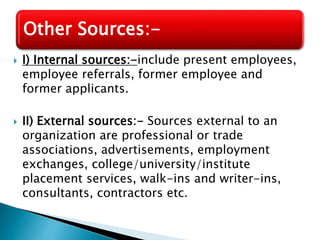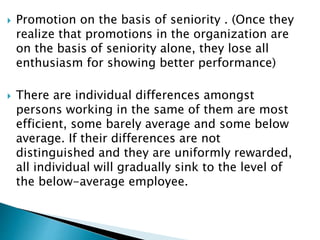ppt on Human resources management recruitment
- 2. HRM is the management of the organization’s employees. This includes employment & arbitration in accord with the low ,& with a company is directives. HRM is the most critical function of manager. The main function is the focus on recruitment of management, & providing direction for the people who work in the organization Introduction:-
- 3. “It is the organizational function that deal with issues related to people such as compensation, hiring, performance management, organization development, safety, wellness, benefit, employee motivation, communication & training” Definition:-
- 4. INTRODUCTION:- Recruitment is an important function of health manpower management, which determines, whether the required will be available at the work spot, when a job is actually to be undertaken. Recruitment:-
- 5. In a simple term, recruitment is understood as the process of searching for and obtaining applicants for job, from among whom the right people can be selected’ Meaning: -
- 6. According to B Flippo: “It is defined as the process of searching for prospective employees and stimulating them to apply for job in the organization”. According to IGNOU Module: “It is a process in which the right person for the right post is procured”. Definition:-
- 7. There are “3” types of recruitment: 1. Planned: arise from changes in organization and recruitment policy. 2. Anticipated: by studying trends in the internal and external organization. 3. Unexpected: arise due to accidents, transfer and illness. Types of recruitment:-
- 8. To attract people with multi-dimensional skills and experiences that suit the present and future organizational strategies. To induct outsiders with new perspective to lead the company. To infuse fresh blood at all levels of organization. To develop an organizational culture that attracts competent people to the company. Objectives of recruitment:-
- 9. To search or head hunt people whose skills fit the company’s values. To devise methodologies for assessing psychological traits. To search for talent globally and not just within the company. To design entry pay that competes on quality but not on quantum. To anticipate and find people for positions that does not exist yet.
- 10. Determine the present and future requirements of the organization in conjunction with the personnel planning and job analysis activities. Increase the pool of job candidates with minimum cost Help increase the success rate of the selection process reducing the number of obviously under qualified or over qualified job applicants. Help reduce the probability that the job applicants, once recruited and selected will leave the organization only after short period of time. Purposes and importance:
- 11. Start identifying and preparing potential job applicants who will be appropriate candidates. Increase organizational and individual effectiveness in the short and long term. Evaluate the effectiveness of various recruiting techniques and sources for all types of job applicants.
- 12. Recruitment should be done from a central place. Eg: Administrative officer/Nursing Service Administration. Termination and creation of any post should be done by responsible officers, eg: regarding nursing staff the Nursing superintendent along with her officers has to take the decision and not the medical Superintendent. Only the vacant positions should be filled and neither less nor more should be employed. Job description/ work analysis should be made before recruitment. Principles of recruitment:-
- 13. Procedure for recruitment should be developed by an experienced person. Recruitment of workers should be done from internal and external sources. Recruitment should be done on the basis of definite qualifications and set standards. A recruitment policy should be followed. Chances of promotion should be clearly stated. Policy should be clear and changeable according to the need.
- 14. 1. Direct source 2. Indirect source Sources of recruitment:-
- 15. I) Internal sources:-include present employees, employee referrals, former employee and former applicants. II) External sources:- Sources external to an organization are professional or trade associations, advertisements, employment exchanges, college/university/institute placement services, walk-ins and writer-ins, consultants, contractors etc. Other Sources:-
- 16. Walk-in Consult in Tele recruitment: Organizations advertise the job vacancies through World Wide Web (WWW) Modern sources of recruitment:-
- 17. It was stated earlier, recruitment refers to the process of identifying and attracting job seekers so as to build a pool of qualified job applicants. The process comprises five inter-related stages, via:- Recruitment process / steps:-
- 19. All organization, whether large or small, do engage in recruiting activity, though not to the same extent. This differs with: The size of the organization The employment conditions in the community where the organization is located The effects of past recruiting efforts which show the organization’s ability to locate and keep good performing people. Working conditions an salary and benefit packages offered by the organization- which may influence turnover and necessitate future recruiting The rate of growth of organization Factors effecting recruitment:-
- 20. SELECTION
- 21. “The selection process starts when applications are screened in the personnel department. Selecting includes interviewing, the employer’s offer, acceptance by the applicant, and signing of a contract or written offer”. Those applicants who seem to meet the job requirements are sent blank job-application forms and are directed to fill them up and return the same for further action. The job application form is one of most important tools in the selection process. Introduction:-
- 22. “It is the process of choosing from among applicants the best qualified individuals,, Definition:-
- 23. 1. Application forms:- The issue and receipt of application forms is the administrative responsibility. The information contained in the application form and reports received in connection with them should be systematically tabulated and filed as they are useful for evaluating the effectiveness of the form, analyzing entrance standards, assessing academic achievement with subsequent performance. Selection policies:-
- 24. The application form should elicit the following information:- Name Address Age of the candidate Name of parents or guardians Occupation of father Details of education Details of employment Particular aptitudes or abilities
- 25. It may also ask the employee to write short easy on his/her interests to words nursing profession as a career. It should give details of any material she/he should submit such as a medical certificate, evidence of date of birth etc. and should give the exact address to which it should be sent. The names of the persons given as references should be asked to furnish information regarding the candidate’s character and personality.
- 26. 2. Selection committee:- Usually the selection occurs in the college itself. The members of the selection committee should include:- The head of the college of nursing Principal Representative of the local controlling authority
- 27. Steps in selection: The steps which constitute the employee selection process are the following: Steps are:- 1. Pre-employment tests-written/oral/practical 2. Interview 3. Interview by department head 4. Decision of administrator to accept or reject 5. Medical examination 6. Check of references/ Verification 7. Issue of appointment letter.
- 28. 1. Pre-employment tests: To ensure selection of the most suitable candidates for various posts pre-employment tests should be held in a systematic manner wherever necessary & possible. These tests can broadly be divided in to four types: ◦ Tests of general ability- intelligence ◦ Tests of specific abilities- aptitude tests ◦ Tests of achievement-trade tests ◦ Personality tests- Tests of emotional stability, interest, values etc.
- 29. 2. Interviewing Interviewing is the main method of appraising an applicant’s suitability for a post. This is the most intricate and difficult part of the selection process. The employment interview can be divided into four parts: ◦ The warm-up stage ◦ The drawing-out stage ◦ The information stage ◦ The forming an-opinion stage Main objectives of an interview: For the employer to obtain all the information about the candidate to decide about his suitability for the post. To give the candidate a complete picture of the job as well as of the Organization. To demonstrate fairness to all candidates.
- 30. 3.Interview by department head:- In some organization, the selection committee consists of one person from the personnel department, and one representative of the head of the Institute/hospital. After the interviewing all the candidates, the selection committee submits its recommendations for approval to the head of the hospital, who is generally the hiring authority.
- 31. 4. Decision of administrator to accept or reject
- 32. 5. Medical examination: The medical examination of a prospective employee is an aid both to the employee and to the management. The purpose of the medical examination is threefold: a) It is for the protection of the applicant himself to know whether that job will suit him or not from the medical point of view. b) It is for the protection of the other employees so that they are not at risk of any communicable or other disease which the prospective employee may have. c) It is for the protection of the employer as well, so that he may avoid selecting a wrong person. The medical examination will eliminate an applicant whose health is below the standard or one who is medically unfit
- 33. 6. References/ Verification:- The references provided by the applicant should be cross-checked to ascertain his past performance and to obtain relevant information from his past employer and others who have knowledge of his professional competence. The references letters should be brief and should require as little writing as possible by the person to whom it is sent. If it is directed to a former employer, it should ask for the following data: Date of joining ,Date of leaving , Job title Last salary drawn Promotion/demotion, if any Unauthorized absentee record Reason for termination/ leaving Ability to work with others Dependability Emotional stability , Health conditions Any other information
- 34. 7. Joining report by the employee: When new employees reports for joining, he should be given an appointment letter, his job description and handbook of the hospital/Institute. He/She should be asked to submit his joining report
- 35. 3. Orientation programme: After selection an orientation programme is to be conducted to make the employee aware of the college rules, hostel rules and the hospital and the college building and associated parallel medical education departments. Orientation should be given by a senior faculty of the college of nursing.
- 37. The promotion policy is one of the most controversial issues in every organization. The management usually favors promotion on the basis of merits, and the unions generally oppose it by saying that managements resort to favoritism. The unions generally favor promotions on the basis of seniority. It is hence essential to examine this issue and arrive at an solution. INTRODUCTION:-
- 38. “A change for better prospects from one job to another job is deemed by the employee as a promotion”. OR “It is refers to the advancement an employee's rank or position in a hierarchical structure” DEFINITION:-
- 39. The factors which are considered by employees as implying promotion are: FACTORS IMPLYING PROMOTION:- FACTORS IMPLYING PROMOTION An increase in salary An increase in prestige An upward movement in the hierarchy of jobs Additional supervisory responsibility A better future
- 40. Seniority versus merits: There has been great deal of controversy over the relative values of seniority and merit in any system of promotion. Seniority will always remain a factor to be considered, but there be much greater opportunity for efficient personnel, irrespective of their seniority, to move up speedily if merit is used as the basis for promotions. It is often said that at least for the lower ranks, seniority alone should be the criterion for promotion. One cannot agree with this. NATURE AND SCOPE OF PROMOTION:
- 41. The quality of work is more important in the lower ranks as in the higher. There are some who argue against this plan and advocate the merit policy for the following reasons: They believe that more length of service evidence only of continued service but are surely no indication of vast experience.
- 42. Promotion on the basis of seniority . (Once they realize that promotions in the organization are on the basis of seniority alone, they lose all enthusiasm for showing better performance) There are individual differences amongst persons working in the same of them are most efficient, some barely average and some below average. If their differences are not distinguished and they are uniformly rewarded, all individual will gradually sink to the level of the below-average employee.
- 43. Promotion policy may include the following: Charts and diagrams showing job relationships and ladder of promotion should be prepared. There should be some definite system for making a waiting list after identification and selection of those candidates who are to be promoted as and when vacancies occur. All vacancies within the organization should be notified so that all potential candidates may complete. PROMOTION POLICY:-
- 44. The following eight factors must be the basis for promotion: Outstanding service in terms of quality as well as quantity Above average achievement in patient care and for public relations Experience Seniority Initiative Recognition by employee as a leader Particular knowledge and experience necessary for a vacancy and Record of loyalty and cooperation
- 45. In some instances, it may be possible to use pre-employment test, to determine eligibility for the vacant position. Though the department heads may initiate promotion of an employee, the final approval should be with top management. The personnel department can help at the stage by proposing the names of prospective candidates out of the existing employees in the organization and also submit their performance appraisal record of the last few years to the department head. All promotion should be for a trail period. In case the promoted person is not found capable of handling the job. In case of promotion, the personnel department should carefully follow the progress of the promoted employees. A responsible person of the personnel department should hold a brief interview with the promoted person and his department head to determine whether everything is going on well or not.
- 46. It provides an incentive to employee to work more and show interest in their work. They put in their best in their best and aim for promotion within the organization. It develops loyalty amongst the employees, because a sound promotion policy assures them of their promotions if they are found fit. ADVANTAGES OF A SOUND PROMOTION POLICY:
- 47. It increases satisfaction among the employees. It generates greater motivation as they do not have to depend on mere seniority for that advancement. Finally, increases the effectiveness of an organization
- 48. Difficult human relations problem can arise in promotion cases ◦ In promoting an employee to a better job, his salary should be at least one step above his present salary. ◦ Specific job specifications will enable an employee to realize whether or not his qualifications are equal other. SOLUTION TO PROMOTION PROBLEMS:
- 49. ◦ There should be a well-defined plan for informing prospective employees may know the various avenues for their promotion. ◦ The organization chart and promotion charts should be made so that employees may know the various avenues for their promotion. ◦ The promotion policy should be made known to each and every organization. Management should prepare and practice promotion policy sincerely
- 51. Is a retirement fund (Including Pension)give to the employee at the time of retirement. Introduction:-
- 52. Fall in to three categories:- A. Preserved benefit. B. Restricted non reserved benefit C. Unrestricted non reserved benefit Superannuation Benefit:-
- 53. A. Preserved benefit:- are benefit that must be retained in a superannuation fund until the employee’s preservation age/retirement age. B. Restricted non reserved benefit:-although not preserved, cannot be accessed until an employee meets a condition of release, such as terminating their employment in an employer superannuation scheme. C. Unrestricted non reserved benefit:- do not require the fulfilment of a condition of release & may be accessed upon the request of the worker, eg where a worker has previously satisfied a condition of release & decided not to access the money in their superannuation fund





















































